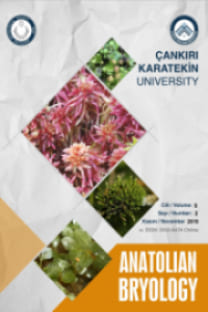Azize YAVUZ' & Gökhan ABAY”
The Urban Moss Flora of the Çankırı City (NW, Turkey)
Flora, Urban mosses, Human impact Categorical variables, Turkey,
___
- Bargagli R. 1998. Trace elements in terrestrial plants: an ecophysiological approach to biomonitoring and biorecovery: Springer-Verlag Berlin Heidelberg, New York, 324 p.
- Barrico L. Azul A.M. Morais M.C. Coutinho A.P. Freitas H and Castro P. 2012. Biodiversity in urban ecosystems: Plants and macromycetes as indicators for conservation planning in the city of Coimbra (Portugal). Landscape and Urban Planning. 106, 88-102.
- Çepel N. 1995. Orman Ekolojisi. İstanbul Üniversitesi Orman Fakültesi, Toprak İlmi ve Ekoloji ABD, Üniv. Yayın N0: 3886. ISBN: 975-404-398-1, İstanbul, 536 p.
- Delgadillo M.C and Cardenas S. A. 2000. Urban mosses in Mexico City. Anales Del Instituto de Biologia Universidad Nacional Autönoma de Mexico. Serie Botânica 71 :2, 63-72.
- Directorate General of Meteorology 2013. Çankırı Meteoroloji Bülteni, Ankara: T.C. Çevre ve Orman Bakanlığı Devlet Meteoroloji İşleri Genel Müdürlüğü Kayıtları (1960—2013).
- Drugova T.P. 2010. Mosses of Monchegorsk city (Murmansk province, North-West Russia). Arctoa. 19:165—170.
- Durdié S. Stojkovic' S and Sabié D. 2011. Nature conservation in urban conditions: A case study from Belgrade, Serbia. Maejo International Journal of Science and Technology. 5: 1, 129-145.
- Environmental Status Report 2014. Environmental status report of Çankırı city belonging to 2013, Çankırı: Governorship of Çankırı, Provincial directorate of environment and urban planning.
- Fojcik B. and Stebel A. 1999. Preliminary studies on the bryoşora of Katowice town (Silesian Upland, Southern Poland). Fragmenta Floristica et Geobotanica. 44: 129—140.
- Fojcik B and Stebel A. 2006. Chosen aspects of threatened moss species occurrence in urban areas- a case study of Katowice. Biodiversity: Research and Conservation. 1-2: 187-189.
- Fudali E. 2012. Recent tendencies in distributions of epiphytic bryophytes in urban areas: A Wroclaw case study (South—West Poland). Polish Botanical Journal. 57: 231—241.
- Gilbert CL. 1970. Further studies on the effect of sulphur dioxide on lichens and bryophytes. New Phytologist. 69: 605—627.
- .......................... Anatolian Bryology 2015 1(1) 42-60
- Grdovié S and Stevanovic’ V. 2006. The moss şora in the central urban area of Belgrade. Archives of Biological Science. 58: 55-59.
- Greven HQ 2003. Grimmias of the World. The Netherlands, Leiden: Backhuys Publishers, 247 p.
- Heyn C.C. and Herrnstadt I. 2004. The Bryophyte Flora of Israel and Adjacent Regions. Jerusalem: The Israel Academy of Sciences and Humanities, 719 p.
- Hill MO. Preston CD and Smith A.J.E. 1992. Atlas of the Bryophytes of Britain and Ireland. 2nd Edition, Colchester, UK: Harley Books, 400 p.
- Hill M.O. Bell N. Bruggeman-Nannenga M,A. Brugués M. Cano M.J. Enroth J. Flatberg K.I. Frahm J.P. Gallego M.T. Garilleti R. et al. 2006. An annotated checklist of the mosses of Europe and Macaronesia. Journal of Bryology. 28: 198—267.
- Hill MO. Preston C.D. Bosanquet S.D.S. Roy DE. 2007. BRYOATT - Attributes of British and Irish Mosses, Liverworts and Hornworst. With information on native status, size, life form, life history, geography and habitat. Cambridgeshire: Published by Centre for Ecology and Hydrology, 88 p.
- Isermann M. 2007. Diversity of bryophytes in an urban area of NW Germany. Lindbergia. 32: 75 -81.
- Jim C.Y. and Chen W.Y. 2011. Bioreceptivity of buildings for spontaneous arboreal şora in compact city environment. Urban Forestry & Urban Greening. 10: 19-28.
- Kirmaci M. and Ağcagil E. 2009. The bryophyte şora in the urban area of Aydın (Turkey). International Journal of Botany. 5: 216—225.
- Lo Giudice R. Mazimpaka V. and Lara F. 1997. The urban bryophyte şora of the city of Enna (Sicily, Italy). Nova Hedwigia. 64: 249-265.
- Pokomy L. Lara F. and Mazimpaka V. 2006. The bryophyte şora of the city of Trento (North Italy). Cryptogamie Bryologie. 27: 265-284.
- Ron E. Soria A. Ballesteros T. G6mez D. and Fernandez F. 2008. Flora brioştica de las ciudades de Toro y Benavente (Zamora, Espana). Botanica Complutensis. 32: 63-68.
- Sabovljevié M. and Grdovié S. 2009. Bryophyte diversity within urban areas: case study of the city of Belgrade (Serbia). International Journal of Botany. 5: 85-92.
- Sabovljevié M. and Sabovlj evié A. 2009. Biodiversity within urban areas: A case study on bryophytes of the city of Cologne (NRW, Germany). Plant Biosystems. 143: 473 -481.
- Skudnik M. Sabovljevic’ A. Batic F. and Sabovljevié M. 2013. The bryophyte diversity of Ljubljana (Slovenia). Polish Botanical Journal. 58: 319-324.
- Smith A.J.E. 2004. The Moss Flora of Britain an Ireland. Cambridge: Cambridge University Press, 1026 p.
- SPSS 2012. Institute Inc. SPSS Base 20.0 User’s Guide.
- ISSN: 2149-5920
- Yayın Aralığı: 2
- Başlangıç: 2015
- Yayıncı: Çankırı Karatekin Üniversitesi
Nermin Gündüz KESİM] & Serhat URSAVAŞ*2
Zonguldak İli Briyofit Florasına Katkılar
MUHAMMET ÖREN, SEZGİ BOZKAYA, AYŞE ÖZÇELİK, YASİN HAZER, GÜRAY UYAR
Türkiye’deki Barbilophozia lycopodioides (Wallr.) Loeske., (Scapaniaceae, Hepaticae) üzerine notlar
MEVLÜT ALATAŞ, NEVZAT BATAN, TURAN ÖZDEMİR
Beldibi ve Babadağ Ormanlarının Epifitik Briyofitleri (Zonguldak, Türkiye)
MEVLÜT ALATAŞ, TÜLAY EZER, RECEP KARA, NEVZAT BATAN
Nermin Gündüz KESİM] & Serhat URSAVAŞ*2
